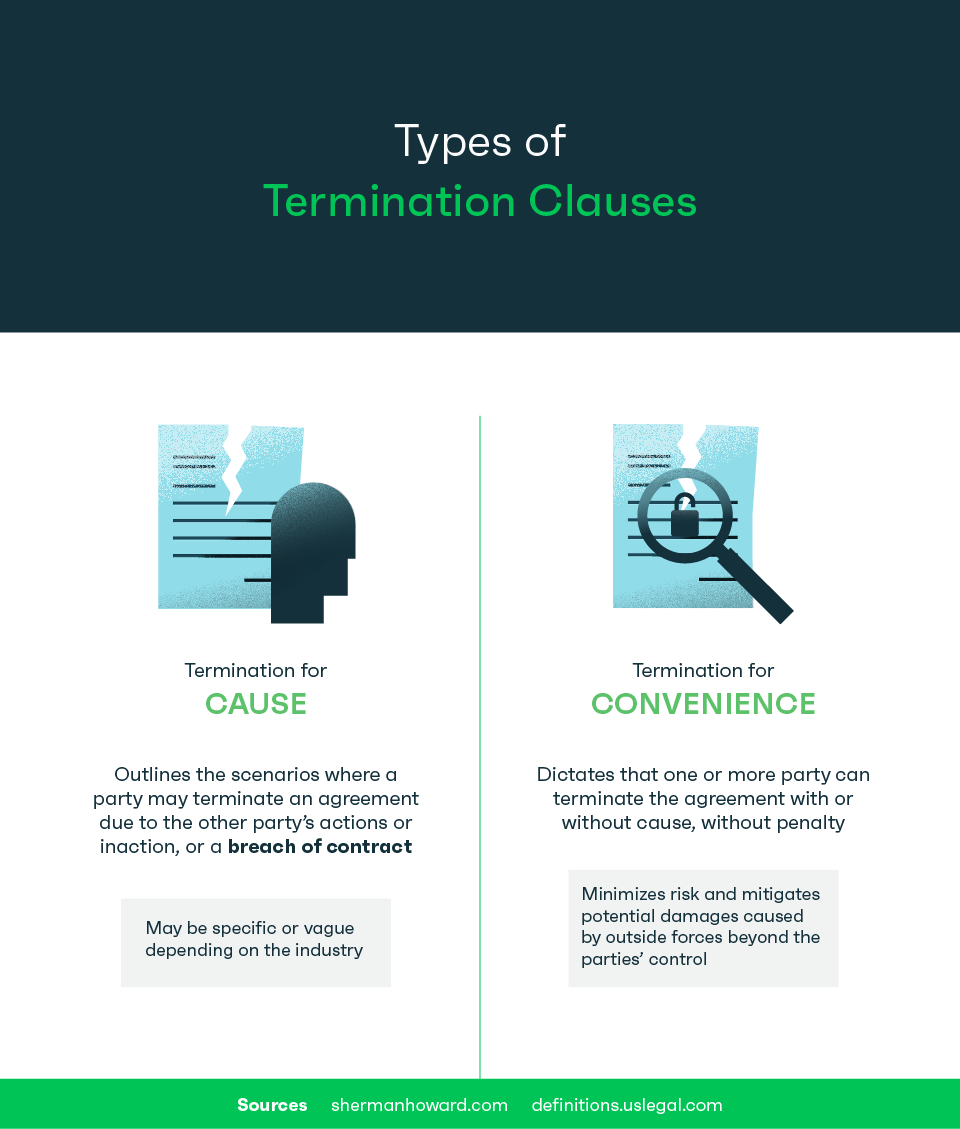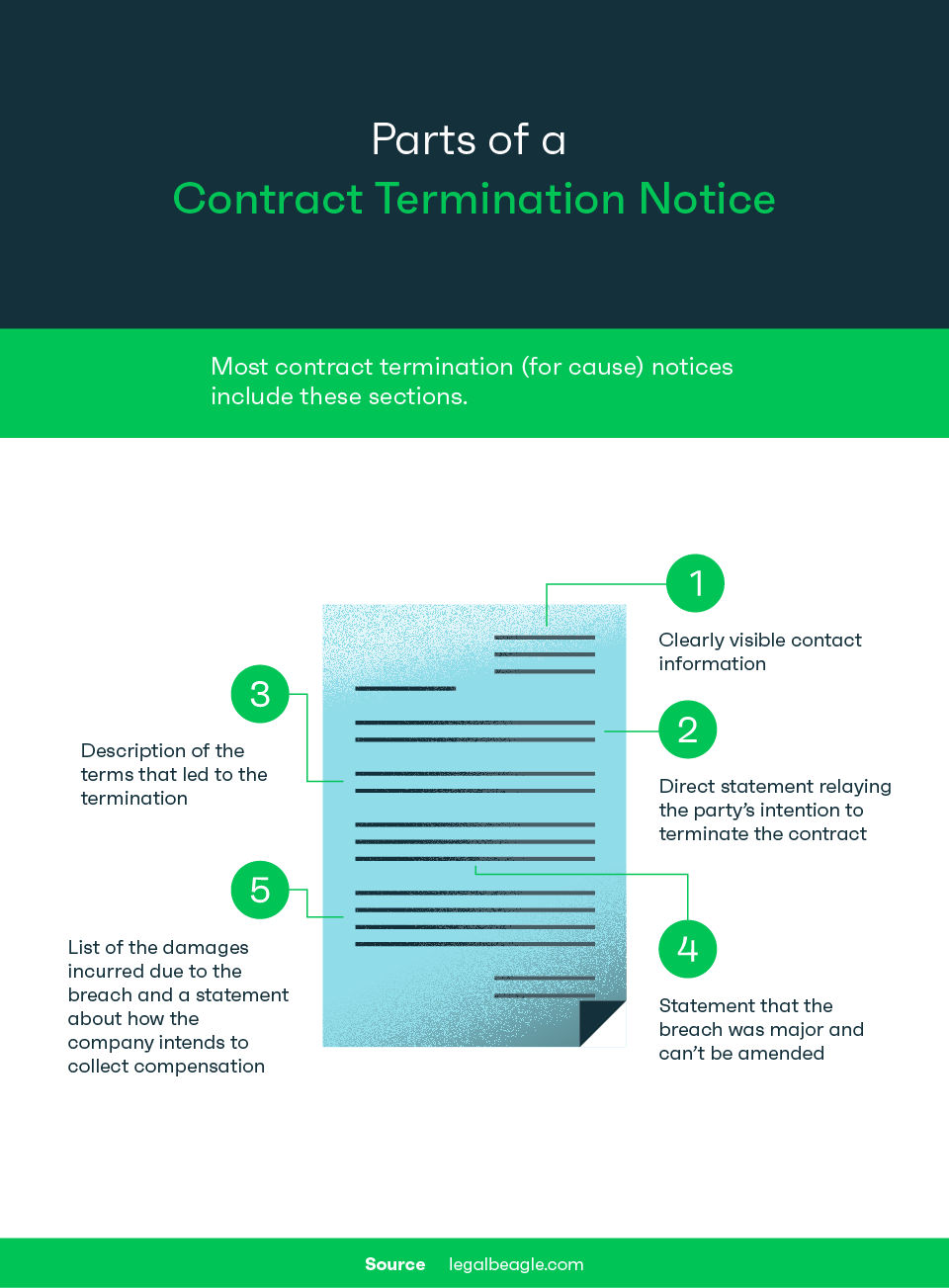Contracts establish transparent and professional partnerships between companies and individuals. However, it’s vital to have an exit strategy. Termination clauses are critical to sound and enforceable contracts, but they can be tricky. What circumstances would warrant a reasonable termination? What terminology should parties be aware of to mitigate damages caused by a sudden split? This article will examine just causes for termination, and explain how to create and identify termination clauses and write a termination of contract notice.
How to Terminate a Contract
To understand how to terminate a contract, it’s necessary first to address the definition of a contract. As we have previously covered, a contract is defined as a set of terms agreed upon by willing parties with capacity in exchange for something. It contains an offer, acceptance, and consideration, also known as an exchange of value. A contract binds both parties to adhere to certain obligations for a set amount of time.
However, circumstances could occur that would void the legality of the contract and terminate contractual obligations. Most contracts contain termination clauses that lay out these possible scenarios in detail. Generally, there are two types of termination clauses: termination for cause and termination for convenience.

Termination for Cause
Most contracts contain one or more scenarios in which a party may terminate an agreement due to the other party’s actions or inaction, or a breach of contract. A breach of contract exists when one or both parties do not fulfill the obligations of the contract.
Termination for cause clauses can be highly specific or vague depending on the industry, ordinary course of performance, and nature of the contract. For example, if a project depends on the completion of a service upon a specific date, and a party fails to perform on that date, the party’s inaction could trigger termination based on that single breach.
Occasionally, minor breaches will occur that don’t materially alter the agreement. Parties can amend the contract, or even include clauses to account for minor or insignificant breaches. However, when material breaches occur, a party may seek termination of the agreement as well as monetary damages related to the inaction of the other party.
For example, imagine Company A signs a contract with Company B for the delivery of small green widgets each month to Company A’s vendors. Company B instead delivers large red widgets, which are unusable to the vendors. This action would constitute a material breach of contract, if provided for in the agreement. Company A could terminate their contract with Company B and request damages relating to the inconformity to the terms of their agreement.
Termination for Convenience
A termination for convenience clause dictates that one or both parties may terminate the contract with or without cause, and without penalty. A termination for convenience clause is an excellent way to minimize risk, especially in industries where circumstances may change rapidly without time to alter or amend a contract. It’s also a great way to mitigate potential damages caused by events outside the parties' control.
To illustrate the importance of termination for convenience provisions, it’s useful to look at real-life scenarios. The coronavirus pandemic in the spring of 2020 wreaked havoc on industries, most notably in travel and hospitality. Companies that had termination for convenience clauses or force majeure clauses (which suspend one or both parties’ performance obligations under a contract in the case of unforeseen and uncontrollable events, such as pandemics) in their contracts were in better shape. For example, imagine a company had included a well-written termination for convenience clause in a contract with a vendor. If the pandemic prevented the vendor from doing work, the company could terminate the contract without the risk of being sued for breach of contract.
In a study published in April 2020, Kira Systems collected 132 agreements filed on EDGAR from a wide variety of commercial industries. We analyzed the prevalence of termination for convenience clauses through our AI-based provision model. We found that fewer than half of the contracts contained termination of convenience clauses, limiting solutions between contracting parties when a natural and unforeseen event occurs. Companies in service-based industries should analyze current contracts for termination for convenience provisions and include them in future agreements, if appropriate.
What to Do If a Contract Lacks a Termination Clause
If a contract lacks a termination clause, the parties still have viable options to change the agreement and mitigate risk. First, the parties could amend an existing contract to include a termination clause. Of course, requesting the addition of a termination clause, especially a termination for convenience, poses its own risks. However, if the requesting party lays out specific scenarios for termination, clearly defining behaviors or events that would result in termination of the contract, the other party may appreciate the additional clarity.
Moving forward, parties should ensure that future contracts contain termination clauses in line with their industry’s risks and foreseeable circumstances.
The Anatomy of a Termination Clause
A clearly defined termination provision is key when a company needs to terminate a contract, either for cause or convenience. The location of termination clauses can be industry specific. Look for them after the definition of the terms and conditions of an agreement. A well-written termination clause can help a company avoid costly litigation and define boundaries between parties. Strategically, termination provisions can protect a business from potential catastrophe caused by a breach of terms or other events.
While the courts prefer to give companies the freedom to create agreements, limitations in termination clauses are embedded in general contract law. For example, the courts expect a covenant of good faith and fair dealings, meaning that both parties agree to do their best to honestly fulfill the duties in the contract. A court may interpret a poorly executed termination for convenience clause as a major breach and provide access to compensation by the injured party.

What Happens When a Company Terminates a Contract?
When a company terminates a contract, it often provides written notice to the other party through a termination of contract notice. Depending on the applicable contract terms, the company may need to provide additional documentation or information relating to the termination.
The notice should lay out the events and legal reasoning supporting the company’s reasons for terminating the contract. It may or may not provide the other party with the next steps they can take post-termination.
For example, an employer may provide an employee whose contract has been terminated with instructions on how to sign up for post-employment health insurance and collect unemployment benefits.
How to Write a Termination of Contract Notice
A contract termination notice is a formal documentation of a party’s intention to cease the completion of its duties under the agreement. When drafting a termination notice, review the contract thoroughly to ensure that the terminating party followed the protocol outlined within the original agreement.
Getting started can be challenging. Online templates abound, but they may not be legally sound. A party can use the general guideline below to begin drafting a termination notice. (These guidelines don’t constitute legal advice. A party should consult a licensed attorney when considering how to terminate a contract.)
- The party writing the letter should have their contact information easily visible at the top of the document.
- The first paragraph should begin with a direct and concise statement relaying the intention to terminate the contract.
For example: “This letter is to notify Company A that Company B will terminate our agreement effective immediately.”
- Refer back to the terms in the contract that led to the termination.
For example: “On January 12, 2019, Company A did not fulfill the duties of the contract when they failed to deliver green widgets within the specified delivery time.”
- Specify that the breach was major and cannot be amended.
For example: “This constitutes a major breach, and therefore the contract shall be terminated.”
- List any damages incurred due to the breach and how the company intends to proceed to collect compensation.
For example: “Due to the non-delivery of green widgets, Company B, in order to mitigate damages to its vendors purchased alternative green widgets from Company C, at an increased cost of $1.00 per widget. Company B incurred damages from the delay and sustained increased costs of $150,000. We will send a subsequent letter in 30 days outlining how we shall proceed to collect these damages.”

Conclusion
Termination clauses help companies protect their interests and set appropriate boundaries with other companies and individuals. When reviewing and analyzing contracts, a company should carefully examine termination provisions. It can mean the difference between a company surviving or closing operations during unforeseen events.
